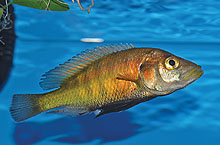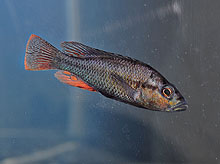WHAT'S NEW ACROSS THE WORLD
Select date in side bar to go to a What's New of previous issues
| What's New
©by Laif DeMason
Have you bought any new cichlids lately? I’m not sure why, but cichlid hobbyists are a bit more selective than in the recent past. Some of the more popular fishes are slowly taking a back seat whereas a new-found trend has yet to emerge. Maybe it was the lack of new fish imports while African exporters try more direct sales techniques. Whatever the reason, hobbyists seem to be looking for something new and interesting, but yet not the usual fish at the same time.
Here’s “what’s new” on the cichlid scene: |
Lake Tanganyika
Collections have finally geared back up after a lengthy post-New Year break. Most of the fish collections are now organized via Tanzania and generally shipped from there regardless if they are caught elsewhere in Zambia or not. Some of the old Burundi fishes are now being collected via Tanzania as well. Meanwhile a good supply of different captive bred Tanganyika cichlids are sold at a small size.
| WHAT'S NEW: LAKE TANGANYIKA |

Hobbyists looking for something out of the usual have set their eyes on some of the wild shell dwellers. Recent imports have included both Lamprologus similis from Kabogo (shown), Tanzania and L. brevis from Karilani Island, Tanzania. Photo by A. Konings.
|

Another out-of-the-norm request has been for different Callochromis species, usually found on sandy bottoms. Pictured here is a male C. sp. ‘pleurospilus tanzania’ from Utinta, Tanzania, where there is a large sandy bay, so collecting the original breeding stock was not difficult. Photo by A. Konings.
|

Another not often imported cichlid is the Tropheus moorii from Kapampa, Congo, often sold as Lime Spot because of the green-white central body patch. This fish is best kept in larger groups to show off their great colors and active behaviors. Photo by A. Konings.
|

More recently, a seldom seen import, Neolamprologus cunningtoni from the Kipili area of Tanzania has been collected. This fish can get much larger than most wild lamprologines so adequate space needs must be adhered to. Photo by A. Konings.
|
Lake Malawi
Wild Malawi collections and exports have been hitting on all cylinders. Fish are being collected by the truckload. Maybe the encouragement comes from the strong Chinese demand. Or the European lack of appetite for Tanganyikans. There are reports of new wild caught fish collections from the Mozambique side once again after no activity for years!! No discounts offered from there…

A great fish pictured here has recently been collected at Tumbi Reef in Tanzania: Pseudotropheus purpuratus. Males sport a bright orange-yellow face on a sky-blue body. Females are mostly gray. This fish reminds me of the cichlids we called “Apricot Zebra” from Cape Maclear in the 1970s, but way more colorful!
|

Definitely a new species and first sold as an Aulonocara, is the recently arrived Placidochromis sp. ‘long nose’ from the Itungi Port area in Tanzania. Only a few males were exported to different countries, including the USA. The full male coloration is not known, but the reddish shoulder patch is promising.
|

Another great little mbuna to be collected again of late is the Cynotilapia zebroides from Cobwé, Mozambique. They are also called the “Orange Back Afra” due to the male’s vibrant orange head and alternating orange upper half-body barring. This presents a great chance to upgrade our breeding stock with fresh wild genes. Photo by A. Konings.
|

Some of the rarer bred cichlids have been in demand of late as well. Pictured here is the so-called albino Aulonocara Flavescent peacock. Oddly, it appears that this strain is not actually a true albino form in the strict sense, but rather some kind of leucistic form where a combination of pigments is lacking.
|
| WHAT'S NEW: LAKE VICTORIA |

Originally from the Lake Kyoga drainage area, Haplochromis sp. ‘red parvidens’ is still being kept by some dedicated individuals. The Parvidens name was originally and erroneously applied to an unknown species over 25 years ago by an expert fish photographer.
|

Also still traded by a few dedicated hobbyists, Prognathochromis perrieri appears from time to time. This dark torpedo-shaped cichlid sports red finnage and is usually not very demanding in care; so many beginning cichlid keepers can have success with this species.
|
Select date in side bar to go a What's New of previous issues |









